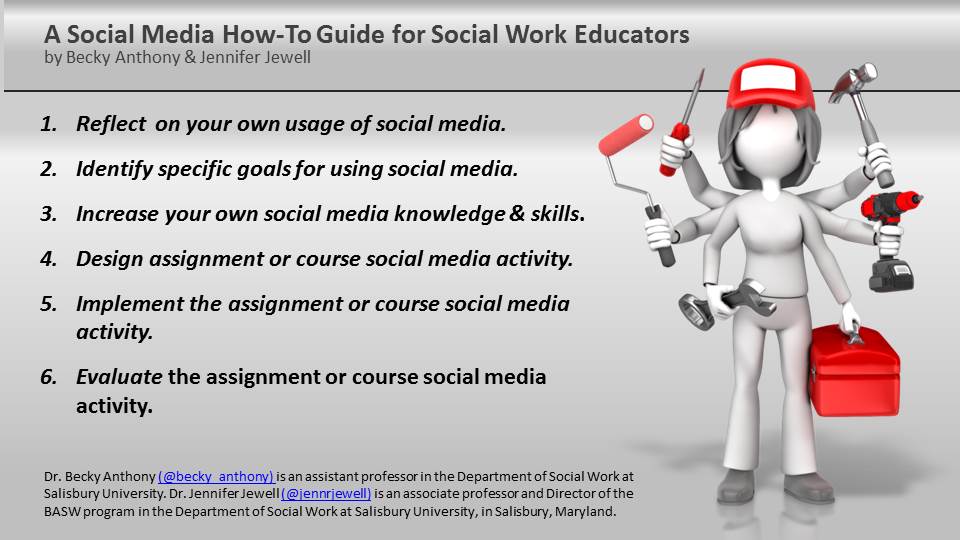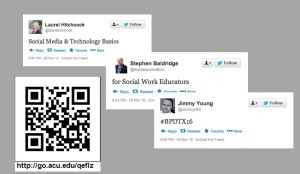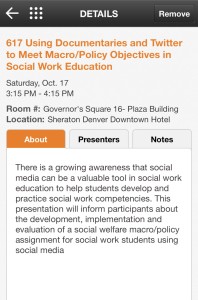#APM16 Day 4 – A Toolkit for Social and Digital Media Policies in Field Education
 It is the last day of CSWE’s 2016 Annual Program Meeting in Atlanta, and I am presenting with one of my favorite UA colleagues, Allison Curington, at 10:00 AM in Atlanta Marriott Marquis Hotel International 8. We will be talking about a project that we have been working on for the past year, a Toolkit for Social and Digital Media Policies in Field Education. Allison and I started collaborating on this toolkit after many, many conversations about the growing use (and misuse) of social media in field education by students, educators and field supervisors. We saw that field directors were increasingly dealing with ethical and practical issues related to the use of social and digital media in field education, and we wanted to provide information and tools to help field directors raise awareness with students and field supervisors.
It is the last day of CSWE’s 2016 Annual Program Meeting in Atlanta, and I am presenting with one of my favorite UA colleagues, Allison Curington, at 10:00 AM in Atlanta Marriott Marquis Hotel International 8. We will be talking about a project that we have been working on for the past year, a Toolkit for Social and Digital Media Policies in Field Education. Allison and I started collaborating on this toolkit after many, many conversations about the growing use (and misuse) of social media in field education by students, educators and field supervisors. We saw that field directors were increasingly dealing with ethical and practical issues related to the use of social and digital media in field education, and we wanted to provide information and tools to help field directors raise awareness with students and field supervisors.
In our interactive workshop today, we plan to present on the toolkit for the first time and pilot one of the tools – Social Media Policy Checklist and Worksheet for Social Workers. We hope you will join us.
Social Media How-To Guide for Social Work Educators
 This post was written by Drs. Becky Anthony and Jennifer Jewell. Dr. Becky Anthony (@becky_anthony) is an assistant professor in the Department of Social Work at Salisbury University. Dr. Jennifer Jewell (@jennrjewell) is an associate professor and Director of the BASW program in the Department of Social Work at Salisbury University, in Salisbury, Maryland. In this blog post, they write a guide for how social work educators can best utilize social media to meet their educational goals.
This post was written by Drs. Becky Anthony and Jennifer Jewell. Dr. Becky Anthony (@becky_anthony) is an assistant professor in the Department of Social Work at Salisbury University. Dr. Jennifer Jewell (@jennrjewell) is an associate professor and Director of the BASW program in the Department of Social Work at Salisbury University, in Salisbury, Maryland. In this blog post, they write a guide for how social work educators can best utilize social media to meet their educational goals.
With the changing nature of educational delivery and knowledge consumption, social work educators are increasingly utilizing social media to help students meet course learning goals and objectives. Students are able to use social media to network with social work professionals, enhance connections between peers, advocate and raise awareness about social concerns, and find resources that help them practice effective social work (Jewell & Anthony, 2016). Some social work educators want to utilize social media in their courses to help students meet learning goals, but are unsure about how to get started. This blog post reviews steps to help social work educators prepare and implement social media assignments and activities into the classroom.
STEP 1: Think about and reflect on your own usage of social media. You need to determine what you will do to abide by professional ethical standards, maintain your own personal boundaries, and explore how you will utilize social media. In this first step, you will create social media guidelines for the course, the department, and/or the professional self. Laurel Hitchcock provides an effective and thorough example of that here: My Guidelines for using Digital and Social Tech in the Classroom and Beyond. This first step allows you to learn about your own professional usage of social media and your own personal boundaries and professional ethics.
STEP 2: Identify specific goals for using social media in this course or with this specific assignment. Once goals are established, you will need to research the different tools (specific social media platforms). For example, Instagram is utilized to share photos and videos and Twitter only allows for 140 characters in each post. Social work educators, during step two, should answer the following questions: 1. What do you want the students to learn? 2. What social media method will work best to achieve this goal?
STEP 3: Increase your own social media knowledge and skills. Specifically, focus on the social media platform you will utilize in your course. You will find it helpful to create an account (if you do not already have one), watch tutorial videos online, utilize tip guides, and practice using this social media before asking your students to use it. This becomes very important because a number of students will not have previously utilized this social media platform and will ask you questions about how to get started and where to find resources.
Social Media and Technology Basics for the Social Work Educator – #BPDTX16
 Welcome to #BPDTX2016! Stephen Baldridge of Abilene Christian University and I are facilitating a pre-conference workshop about social media basics for the social work educator on 3/30/16 from 1:00 – 4:00 PM. We originally created this workshop with Jimmy Young of California State University – San Marcos, but he won’t be making it to BPD this year.
Welcome to #BPDTX2016! Stephen Baldridge of Abilene Christian University and I are facilitating a pre-conference workshop about social media basics for the social work educator on 3/30/16 from 1:00 – 4:00 PM. We originally created this workshop with Jimmy Young of California State University – San Marcos, but he won’t be making it to BPD this year.
Our goal for the workshop is to introduce social work educators to the world of social and digital technologies that can be effectively incorporated into the classroom. We will help bridge the gap between understanding and best practice by demonstrating how to use some of the social media platforms. Upon completion, participants will have several practical, “usable” tools to immediately implement in their courses.
Learning Objectives for the workshop include:
1. Understand how a minimum of 3 social media platforms can be incorporated into assignments for social work courses.
2. Recognize/identify a minimum of 2 ways using social and digital media can promote professional development among social work educators.
3. Appreciate the role of collaboration to support the development and implementation of technology-based assignments.
Slides for the presentations can be accessed here: http://www.slideshare.net/secret/CSjdjAcaZ9UYHo
Here is a link to my blog post about My Guidelines for using Digital & Social Tech in the Classroom and Beyond.
Using #MacroSW in the Classroom
![]() #MacroSW is a live weekly Twitter chat for anyone interested in macro-level social work practice. The chat partners include practitioners and academics with a passion for working with policy, communities and organizations. In full self-disclosure, I have been an active partner with #MacroSW for almost a year now, and value the opportunity to be part of this online community.
#MacroSW is a live weekly Twitter chat for anyone interested in macro-level social work practice. The chat partners include practitioners and academics with a passion for working with policy, communities and organizations. In full self-disclosure, I have been an active partner with #MacroSW for almost a year now, and value the opportunity to be part of this online community.
Why use #MacroSW in the classroom?
Simply put, it is an incredibly engaging way to learn about macro social work practice. When students participate in an hour-long chat, they are engaging in the principles of Connected Learning, a theory that incorporates the digital technology into the learning process (Ito et al., 2013). Connected Learning suggests that learning in the 21st century must be driven simultaneously by the interests of the learner (Interest-Driven) and the academic requirements (Academically-Oriented) while occurring in an environment that supports openness, sharing and feedback with peers and others (Peer-Supported) (Ito et al., 2013). For example, if the goal of your class is for students to learn social work practice with communities and organizations, #MacroSW offers weekly topics related to social welfare policy, research, and practice with community and organizations (Interest-Driven) that are hosted and attended by a variety of social work professionals including students, academics, policy analysts and practitioners (Peer-Supported). Each chat includes a blog post on our website, numerous resources for the week’s topic, and a chat transcript which allow any social work educator to easily incorporate #MacroSW into a course or a specific assignment (Academically-Oriented).
How can you incorporate #MacroSW into your class?
There are four things you want to consider when creating an assignment with #MacroSW in your class:
1. Setting-up a Twitter Account: Students will need to create a free Twitter account, understand the basics of how to use Twitter, and be familiar with how to participate in a live chat. As the instructor, you will want to model for your students so set-up your own account too. Here are some resources:
My Guidelines for using Digital & Social Tech in the Classroom and Beyond
 I recently started collaborating with a good colleague, Allison Currington of the University of Alabama’s School of Social Work, on a project to develop tools and resources for social work field educators about the professional use of social media in social work practice. After several conversations, we realized we need to walk the walk, if we are going to talk the talk. So, we each decided to take a little journey to explore our own guidelines for using social media in the classroom and in our practice as social work educators. Our end goal is to encourage social work students and field instructors to develop their own professional social media guidelines.
I recently started collaborating with a good colleague, Allison Currington of the University of Alabama’s School of Social Work, on a project to develop tools and resources for social work field educators about the professional use of social media in social work practice. After several conversations, we realized we need to walk the walk, if we are going to talk the talk. So, we each decided to take a little journey to explore our own guidelines for using social media in the classroom and in our practice as social work educators. Our end goal is to encourage social work students and field instructors to develop their own professional social media guidelines.
I started by reviewing what was others were saying about personal social media policies and practices. I reviewed several policies, infographics (such as Social Worker’s Guide to Social Media from the University of Buffalo’s School of Social Work), articles, blog posts with recommendations (such as Dr. Julie Hank’s post), and even my own syllabi. What follows is a set of guidelines that represent my own practices for using digital and social technologies as a social work educator. I would love to hear your comments about these guidelines and would be very interested in any other social workers, students and educators who would be willing to share their own best practices or guidelines for using digital and social media.
Dr. Laurel Hitchcock’s Guidelines for using Digital & Social Technology in the Classroom and Practice
These guidelines outline how I strive to interact with students, colleagues and other professionals when using digital and social media. Digital devices are laptops, tablets, smart phones and any form of wearable technology. Social media are websites and applications that allow people to create and share content and/or participate in social networking.
#APM2015 Using Documentaries and Twitter to Meet Macro/Policy Objectives in Social Work Education

 Today, Dr. Jimmy Young and I are presenting at the 61st Annual Program Meeting of the Council on Social Work Education about our social media assignment using a documentary movie and Twitter. There is a growing awareness that social media can be a valuable tool in social work education to help students develop and practice social work competencies. This presentation will inform participants about the development, implementation and evaluation of a social welfare macro/policy assignment for social work students using social media. In our session, we will The learning objectives for this session include:
Today, Dr. Jimmy Young and I are presenting at the 61st Annual Program Meeting of the Council on Social Work Education about our social media assignment using a documentary movie and Twitter. There is a growing awareness that social media can be a valuable tool in social work education to help students develop and practice social work competencies. This presentation will inform participants about the development, implementation and evaluation of a social welfare macro/policy assignment for social work students using social media. In our session, we will The learning objectives for this session include:
1. Understand how the social media platform Twitter can be incorporated into assignments for social work policy and macro courses.
2. Demonstrate how social work educators can assess attainment of competency among social work students using a social media assignment paired with a Rubric for evaluation of the assignment’s learning outcomes.
3. Appreciate the role of professional collaboration in the development, implementation and evaluation of social media-based assignments.
Here is a link to the Prezi that we will show during the presentation.


